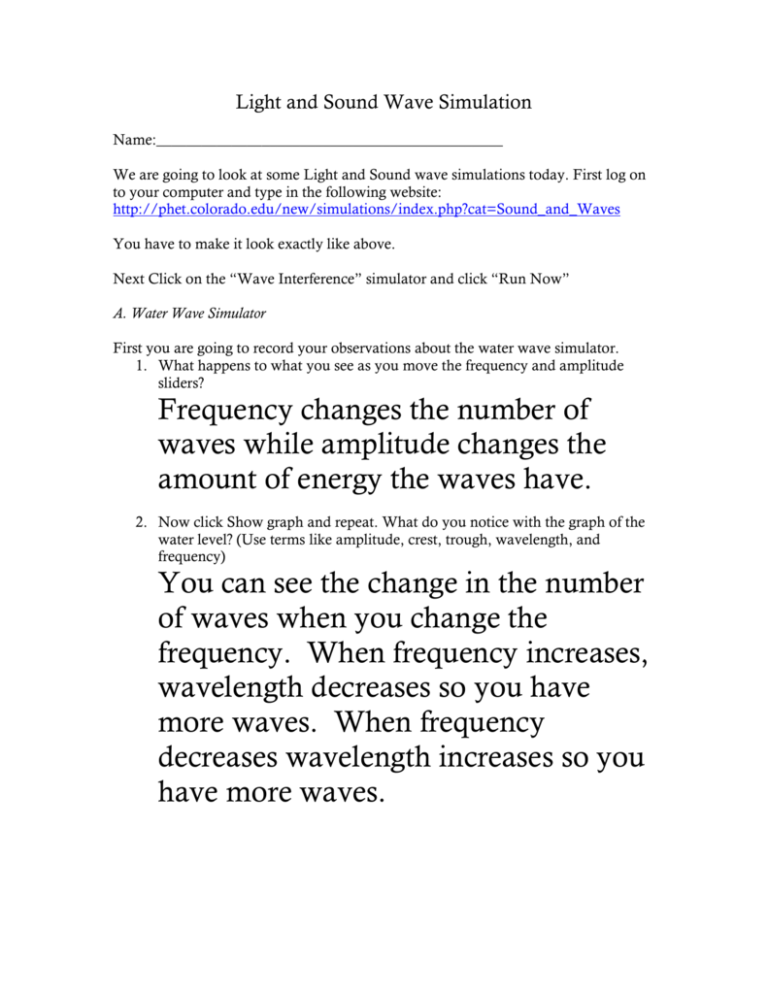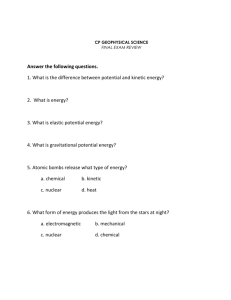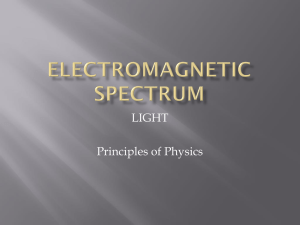Light and Sound Wave Simulation - Lanier Bureau of Investigation
advertisement

Light and Sound Wave Simulation Name:______________________________________________ We are going to look at some Light and Sound wave simulations today. First log on to your computer and type in the following website: http://phet.colorado.edu/new/simulations/index.php?cat=Sound_and_Waves You have to make it look exactly like above. Next Click on the “Wave Interference” simulator and click “Run Now” A. Water Wave Simulator First you are going to record your observations about the water wave simulator. 1. What happens to what you see as you move the frequency and amplitude sliders? Frequency changes the number of waves while amplitude changes the amount of energy the waves have. 2. Now click Show graph and repeat. What do you notice with the graph of the water level? (Use terms like amplitude, crest, trough, wavelength, and frequency) You can see the change in the number of waves when you change the frequency. When frequency increases, wavelength decreases so you have more waves. When frequency decreases wavelength increases so you have more waves. When amplitude changes it affects the distance between the crest and the trough of the wave. More amplitude means there is more energy. 3. Now rotate your view of the water. Record your observations. The actual water looks just like the graph! 4. What happens if you add a second drip? What happens if you space them close together? Far apart? With two drips close together, there is more energy. With the two drips far apart, there are areas where the waves come together and add their energy to each other and areas where they subtract. 5. Turn off the second drip but add a barrier. Record your observations. What happens as you alter the width of the slit? The water bounces (reflects!) off the barrier and back but diffracts through the slit. The small the slit the larger the bend (diffraction). B. Sound Wave Simulator Now click on the top tab that says sound. 1. What do you see? Compressions and rarefactions. 2. What happens when you press the particle button? What happens to the particles as you alter the frequency and amplitude? Record your observations. The particles show how the sound hits the air particles and move them to create waves. The higher the frequency, the more energy is shown and the more waves (shorter wavelength). The higher the amplitude, the more energy shown but the amount of waves does not change. 3. Click show graph. What happens to the graph as frequency and amplitude are The higher the frequency, the more energy is shown and the more waves (shorter wavelength). The higher the amplitude, the more energy shown but the amount of waves does not change. changed? 4. Click on grayscale. What happens when you rotate the view? Record your Longitudinal waves do not look different from any angle. observations. 5. What happens when you turn the speaker off? No sound, therefore no waves. 6. Turn the speaker back on after all the particles become still. 7. Turn on the sound. What happens to the sound as you vary the frequency and amplitude? Change the frequency and you change the pitch (how high or how low the sound). Change the amplitude and you change the loudness of the sound. 8. Put the sliders for frequency and amplitude in the middle. What happens if you add a barrier? What if you alter the barrier? What if you add two? The sound will reflect off the barrier and echo back. C. Light Wave Simulator Now click the top tab that says “light” 1. Click “show graph” and “add detector” 2. What happens when you vary the amplitude? What happens if you put the amplitude at 0? Amplitude determines how bright the light is. Also no amplitude and no frequency means no waves. 3. What happens to the wavelength and frequency as you change the color? The frequency and wavelength change. 4. What can you say about the difference in colors? The frequency and wavelength determine the color of the wave. 5. Now add a slit. Move the slit back and forth. What happens as the slit gets closer and farther from the source? Does changing the color affect this? The amount of diffraction has to do with where the opening is in respect to the source and the color since color affects the wavelength 6. Now set the slit width at 1050 and the barrier location at 2950. Use the target on the detector to compare the amplitudes on each side of the barrier. What happen directly behind the opening versus behind the barrier? The area behind the opening fills first with light then it slowly diffracts around the edges. 7. Click “Show Screen” and “Intensity Graph.” What do you think these represent and are showing? Now take the information you have observed using this simulator and write your conclusions. How do you think altering factors like wavelength and frequency affect they way we see and hear? How does this help us understand how things like lenses and walls can alter the way we see certain lights and hear certain sounds?








